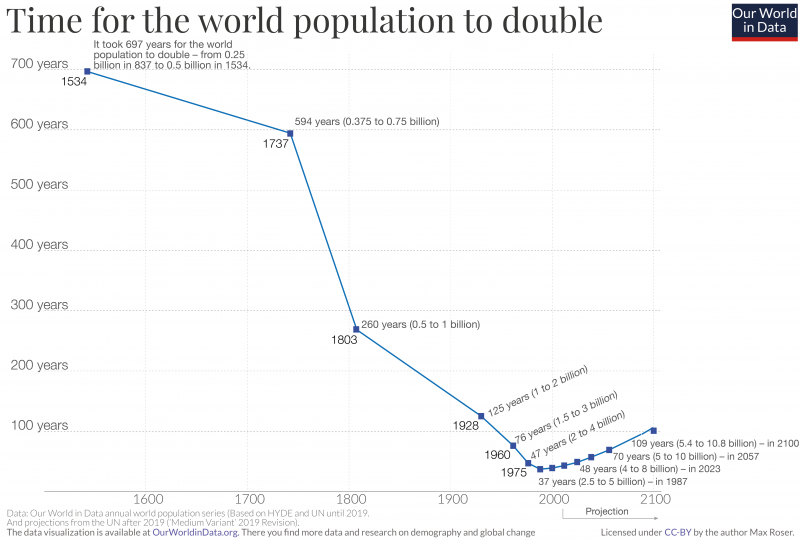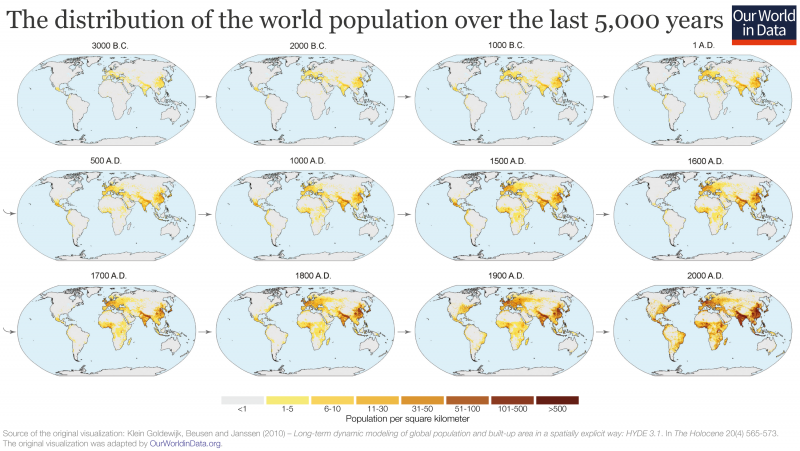Population Growth and Decline Discussion Paper.
Population Growth and Decline Discussion Paper.
This second lab draws heavily on Chapter 4, “Human Populations” in your text. To successfully complete this lab, you will want to study this chapter carefully. You may also find it useful to watch this five-minute video: Population Pyramids: Power Predictors of the Future.
At the most basic level, the increase or decrease in population can be calculated by following this simple formula:
BIRTH RATE – DEATH RATE + IMMIGRATION = GROWTH RATE
Birth and death rates are expressed in a number of different ways. Overall birth rates are often expressed as the number of births per woman over her life. Overall death rates are simply the number of deaths per year. Population Growth and Decline Discussion Paper.
To predict population growth, however, population models use birth and death rates specific to each age group, over a step of five years.
In this lab, you will analyze demographic data for various first, second, and third world countries. As you learned in the text this week, population pyramids generated from this data illustrate the population distribution. Whether countries have a large, young population a large, old population, or a population that is relatively stable, they all have unique challenges to address. This lab will help you further explore the concept of population distributions and its effect on economies and societies.
Begin Work on Your Lab
To begin work on your lab, access:
- Population Growth and Decline Instructions [DOCX].
- Population Growth and Decline Template [DOCX].
Population growth over the long run
There are other ways of visually representing the change in rate of world population growth. Two examples of this are shown in the charts below.
How long did it take for the world population to double?
The visualization shows how strongly the growth rate of the world population changed over time. In the past the population grew slowly: it took nearly seven centuries for the population to double from 0.25 billion (in the early 9th century) to 0.5 billion in the middle of the 16th century. As the growth rate slowly climbed, the population doubling time fell but remained in the order of centuries into the first half of the 20th century. Things sped up considerably in the middle of the 20th century.
The fastest doubling of the world population happened between 1950 and 1987: a doubling from 2.5 to 5 billion people in just 37 years — the population doubled within a little more than one generation. This period was marked by a peak population growth of 2.1% in 1962.Population Growth and Decline Discussion Paper.
Since then, population growth has been slowing, and along with it the doubling time. In this visualisation we have used the UN projections to show how the doubling time is projected to change until the end of this century. By 2100, it will once again have taken approximately 100 years for the population to double to a predicted 10.8 billion.
ORDER A PLAGIARISM FREE PAPER NOW

How long did it take for the world population to increase by one billion?
This visualization provides an additional perspective on population growth: the number of years it took to add one billion to the global population. Also shown in this figure is the number of years projected up to 11 billion based on the UN’s ‘medium variant’ projection.
This visualisation shows again how the population growth rate has changed dramatically through time. It wasn’t until 1803 that the world reached its first billion; it then took another 124 years to reach two billion. By the third billion, this period had reduced to 33 years, reduced further to 15 years to reach four. The period of fastest growth occurred through 1975 to 2011, taking only 12 years to increase by one billion for the 5th, 6th and 7th.
The world has now surpassed this peak rate of growth, and the period between each billion is expected to continue to rise. It’s estimated to take approximately 13 years to reach eight billion in 2024; a further 14 years to reach 9 billion in 2038; 18 years to reach 10 billion in 2056; and a further 32 years to reach the 11th billion in 2088.

Population growth by world region
Two hundred years ago the world population was just over one billion. Since then the number of people on the planet grew more than 7-fold to 7.7 billion in 2019. How is the world population distributed across regions and how did it change over this period of rapid global growth?
In this visualization we see historical population estimates by region from 1820 through to today. These estimates are published by the History Database of the Global Environment (HYDE) and the United Nations Population Division from 1950 onwards.Population Growth and Decline Discussion Paper.
Most people always lived in Asia: Today it is 60% two hundred years ago it was 68%. If you want to see the relative distribution across the world regions in more detail you can switch to the relative view.
The world region that saw the fastest population growth over last two centuries was North America. The population grew 31-fold. Latin America saw the second largest increase (28-fold). Over the same period the population Europe of increased 3-fold, in Africa 14-fold, and in Asia 6-fold.
The distribution of the world population is expected to change significantly over the 21st century. We discuss projections of population by region here.
World population by region
Population growth by country
What are the most populous countries in the world?
Over the last century, the world has seen rapid population growth. But how are populations distributed across the world? Which countries have the most people?
In the map we see the estimated population of each country in 2019. To see how this has changed since 1800, you can use the ‘play’ button and timeline in the bottom-left of the chart. By clicking on any country you can also see how its population has evolved over this period.
Here we see that the top five most populous countries are:
(1) China (1.42 billion)
(2) India (1.37 billion)
(3) United States (329 million)
(4) Indonesia (269 million)
(5) Brazil (212 million)
For several centuries, China has been the world’s most populous country. But not for long: it’s expected that India will overtake China within the next decade. You can learn more about future population growth by country here.
Population, 1800 to 2019
The distribution of the world population over the last 5000 years
This series of maps shows the distribution of the world population over time. The first map – in the top-left corner – shows the world population in 3000 BC.
Population centers have stayed remarkably stable over this long period.

Population growth rate by country and region
Global population growth peaked in the early 1960s. But how has population growth varied across the world?
There are two metrics we can use to look at population growth rates:
(1) ‘Natural population growth’: this is the change in population as determined by births and deaths only. Migration flows are not counted.
(2) Population growth rate: this is the change in population as determined by births, deaths plus migration flows.
Both of these measures of population growth across the world are shown in the two charts. You can use the slider underneath each map to look at this change since 1950. Clicking on any country will show a line chart of its change over time, with UN projections through to 2100.
We see that there are some countries today where the natural population growth (not including migration) is slightly negative: the number of deaths exceed the number of births. When we move the time slider underneath the map to past years, we see that this is a new phenomenon. Up until the 1970s, there were no countries with a negative natural population growth.
Worldwide, population growth is slowing—you can press the play arrow at the bottom of the chart to see the change over time.
Overall, growth rates in most countries have been going down since the 1960s. Yet substantial differences exist across countries and regions.
Whilst Western Europe’s growth rates are currently close to zero, sub-Saharan Africa’s rates remain higher than 3% — that is, still higher than the peak growth rates recorded for the world at the beginning of the 1960s. Moreover, in many cases there has been divergence in growth rates. For instance, while India and Nigeria had similar growth rates in 1960 (around 1.7%), they took very different paths in the following years and thus currently have populations that grow at very different rates (about 1.26% for India compared to 2.67% for Nigeria).Population Growth and Decline Discussion Paper.
Natural population growth, 2015
Natural population growth is the population increase determined by births and deaths. Migration flows are not taken into
account. This is shown from 1950, with UN projections to 2100 based on its median scenario.
Population growth rate, 2015
Annual rate of population change from 1950, including UN projections to 2100 based on its median scenario. This takes
births, deaths and migration into account. Population Growth and Decline Discussion Paper.
Calculate the price of your order
The price of a paper depends on the number of pages, academic level and the urgency. Our prices are discounted and start from as low as $10 per page. To know how much you would pay for an order, fill in the basic paper details.
Confidentiality and Security
We take confidentially of our customers seriously. This is the reason we use only PayPal to make payments that require only an email. This means you can order and pay for your order without disclosing your full identity and with no trace to you or your credit/debit card details as this information is only shared with PayPal, a trusted international payment system. Our website is also encrypted to ensure additional security. In addition, we never sell your paper nor divulge the paper or client details to anyone.
Authenticity
We write all our papers from scratch and never plagiarize at all. Our papers are 100% original with no plagiarism element even when many students place a similar order with us. You are guaranteed of a custom-made non-plagiarized paper that you cannot find anywhere else even in part whenever you order from us.
Professionalism
Professional writers in the various fields who have a wealth of experience in academia write all your papers. You are, therefore, guaranteed of a well-researched paper with the right content and in the correct structure. All our papers are properly referenced and any sources used are correctly cited using your preferred referencing styles such as APA, MLA, OSCOLA, Harvard, Chicago/Turabian, Vancouver, or any other referencing style you prefer.
Our services are legal and acceptable
Do you know that it is legal to seek our academic writing services and is not against the policies of your university, college or any other learning institution?
You are not prohibited from getting our custom-made papers if you use them in any of the following ways;
- As a source for additional understanding of the subject
- As a source of ideas for your research, in this case, it should be properly referenced
- For proper paraphrasing as per your schools plagiarism definition and acceptable paraphrase
- Direct citing in your work, when properly referenced.

